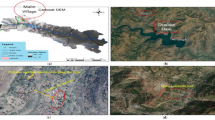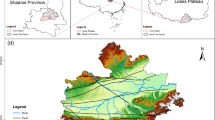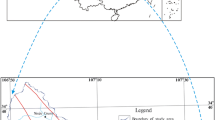Abstract
A rapid-response mapping model can be used to study the susceptibility of areas of interest to geohazards (which are commonly regarded as among the most damaging natural hazards), assuming that the model is stable (i.e., that it is generally applicable to any such area). Applying a predefined predictive geohazard-susceptibility model to an area with geoenvironmental conditions similar to those of the area for which it was originally formulated is an effective method of testing the stability of the model. In this paper, the analytic hierarchy process (AHP)-based model developed for the Wenchuan earthquake was used to study susceptibility to earthquake-triggered slope geohazards in Lushan County. Upon integrating the results of a literature review, site investigation, and remote sensing interpretation, seven main factors that influence earthquake-triggered slope geohazards were identified, including peak ground acceleration, distance from a stream, distance from a highway, slope gradient, slope position, normalized difference vegetation index, and micro-landform. In order to reduce the subjectivity of the expert evaluation method usually applied in the AHP, these factors were ranked by relative importance using regression analysis. The weight of each factor was then calculated by the AHP. The susceptibility mapping model was obtained on the ArcGIS platform, utilizing map overlaying. Finally, the results were re-classified to obtain a map of slope geohazard susceptibility. The accuracy of the AHP model was evaluated using both qualitative and quantitative methods. In the qualitative method, the modeled distribution of susceptibility was compared with the actually distribution of geohazards in the study area (identified through remote sensing interpretation), and the areas with high and very high geohazard susceptibilities in the model were found to match well with the actual locations of slope geohazards. In the quantitative method, statistical data showed that over 66% of the geohazards were located in areas of high or very high susceptibility according to the model, while only about 16% were located in areas of very low or low susceptibility, and the density of slope geohazards was about 125 times greater in the areas with very high susceptibility than in the areas with very low susceptibility. Also, the AUC value of the ROC curve for the model suggested that it has high predictive power (a predictive accuracy of 84.8%). In conclusion, it was possible to make accurate predictions about the slope geohazards in earthquake-prone areas located in mountainous regions based on geospatial data, and a high correlation between the susceptibility map generated by the AHP-based model and the true distribution of slope geohazards was observed. Therefore, the AHP-based model used here could be applied to map the slope geohazard susceptibility in other mountainous regions which may be prone to slope geohazards during earthquakes.




Source: SCGIS website (http://www.scgis.net/yadb/)

Source: SCGIS website (http://www.scgis.net/Isxearthquake/)






Similar content being viewed by others
References
Bui DT, Pradhan B, Lofman O, Revhaug I, Dick ØB (2013) Regional prediction of landslide hazard using probability analysis of intense rainfall in the Hoa Binh province. Vietnam Nat Hazards 66(2):707–730
Chen ZH, Wang JF (2007) Landslide hazard mapping using logistic regression model in Mackenzie Valley. Can Nat Hazards 42(1):75–89. doi:10.1007/s11069-006-9061-6
Chinese Academy of Science (2013) The preliminary results of the fault rupture process inversion. http://www.stdaily.com/special/content/2013-04/24/content_596813.htm. Accessed 24 April 2013. (in Chinese)
Dai FC, Xu C, Yao X, Xu L, Tu XB, Gong QM (2011) Spatial distribution of landslides triggered by the 2008 Ms 8.0 Wenchuan earthquake, China. J Asian Earth Sci 40:883–895
Eidsvig UMK, McLean A, Vangelsten BV, Kalsnes B, Ciurean RL, Argyroudis S, Winter MG, Mavrouli OC, Fotopoulou S, Pitilakis K, Baills A, Malet J-P, Kaiser G (2014) Assessment of socioeconomic vulnerability to landslides using an indicator-based approach: methodology and case studies. Bull Eng Geol Environ 73:307–324. doi:10.1007/s10064-014-0571-2
Harp EL, Keefer DK, Sato HP, Yagi H (2011) Landslide inventories: the essential part of seismic landslide hazard analyses. Eng Geol 122(1–2):9–21. doi:10.1016/j.enggeo.2010.06.013
Huang RQ, Li WL (2009) Analysis of the geohazards triggered by the 12 May 2008 Wenchuan earthquake, China. Bull Eng Geol Environ 68:363–371. doi:10.1007/s10064-009-0207-0
Huang RQ, Xu XN, Tang CA, Xiang XQ (2008) Assessment of geological environmental and management of geological disasters (in Chinese). Chinese Science Press, Beijing
Huang RQ, Wang YS, Pei XJ, Li YS, Li WL, Luo YH (2013) Characteristics of co-seismic landslides triggered by the Lushan Ms7.0 earthquake on the 20th of April, Sichuan Province, China (in Chinese). J Southwest Jiaotong Univ 48(4):581–589. doi:10.3969/j.issn.0258-2724.2013.04.001
Kleinbaum MG, Klein M (2010) Logistic regression-a self-learning text. Springer, USA
Li WL, Huang RQ, Tang CA, Xu Q, van Westen Cees (2013a) Co-seismic handslide inventory and susceptibility mapping in the 2008 Wenchuan earthquake disaster area, China. J Mt Sci 10(3):339–354. doi:10.1007/s11629-013-2471-5
Li WL, Huang RQ, Xu Q, Tang CA (2013b) Rapid susceptibility mapping of co-seismic landslides triggered by the 2013 Lushan earthquake using the regression model developed for the 2008 Wenchuan earthquake. J Mt Sci 10(5):699–715. doi:10.1007/s11629-013-2786-2
Meunier P, Hovius N, Haines AJ (2007) Regional patterns of earthquake-triggered landslides and their relation to ground motion. Geophys Res Lett 34(20):380–408
Meunier P, Hovius N, Haines AJ (2008) Topographic site effects and the location of earthquake induced landslides. Earth Planet Sci Lett 275(3–4):221–232
Nowicki MA, Wald DJ, Hamburger MW, Hearne M, Thompson EM (2014) Development of a globally applicable model for near real-time prediction of seismically induced landslides. Eng Geol 173(2014):54–65
Qi SW, Xu Q, Lan HX, Zhang B, Liu JY (2010) Spatial distribution analysis of landslides triggered by 2008.5.12 Wenchuan earthquake, China. Eng Geol 116:95–108
Rodriguez CE, Bommer JJ, Chandler RJ (1999) Earthquake-induced landslides: 1980–1997. Soil Dyn Earthq Eng 18(5):325–346. doi:10.1016/S0267-7261(99)00012-3
Saaty T (1980) The analytic hierarchy process: planning, priority setting, resource allocation. McGraw-Hill, New York
USGS (2013) M6.6 - 52km WSW of Linqiong, China. http://earthquake.usgs.gov/earthquakes/eventpage/usb000gcdd#summaryAccessed 20 April 2013.
Van Westen CJ, Castellanos E, Kuriakose SL (2008) Spatial data for landslide susceptibility, hazard, and vulnerability assessment: an overview. Eng Geol 102(3–4):112–131. doi:10.1016/j.enggeo.2008.03.010
Wang G (2015) Comparison of the landslides triggered by the 2013 Lushan earthquake with those triggered by the strong 2008 Wenchuan earthquake in areas with high seismic intensities. Bull Eng Geol Environ 74:77–89. doi:10.1007/s10064-014-0574-z
Wang J, Guo J, Wang WD, Fang LG (2012) Application and comparison of weighted linear combination model and logistic regression model in landside susceptibility mapping (in Chinese). J Cent South Univ (Sci Technol) 43(5):1932–1939
Weiss A (2001) Topographic position and landforms analysis. In: ESRI Int User Conf, San Diego, CA, USA, 9–13 July 2001
Wen HJ (2015) A susceptibility mapping model of earthquake-triggered slope geohazards based on geo-spatial data in mountainous regions. Georisk 9(1):25–36. doi:10.1080/17499518.2015.1005634
Wen HJ, Zhang YX, Liu Y (2004) Geological disasters and their damage in Three Gorges reservoir area. (in Chinese). J Chongqing Jianzhu Univ 26(1):1–6. doi:10.11835/j.issn.1674-4764.2004.01.002
Wen HJ, Zhang JL, Xu M (2009) A comprehensive way of safety assessment of high slopes in Three Gorges Reservoir area. Int J Terraspace Sci Eng 1(2):83–86
Wen HJ, Li X, Zhang YX (2010) Study on the georisk mis of high slopes at mountainous region cities. Eng Mech 27:168–171
Wen HJ, Hu DP, Wang GL (2014) A comparative study on the susceptibility mapping of earthquake triggered landslide by neural network and logistic regression model, Wenchuan County. (in Chinese). China Civil Eng J 47(S1):17–23
Xu C, Dai FC, Yao X et al (2009) GIS-based landslide susceptibility assessment using analytical hierarchy process in Wenchuan earthquake region (in Chinese). Chin J Rock Mech Eng 8(2):3978–3985
Xu C, Xu XW, Dai FC, Wu ZD, He HL, Shi F, Wu XY, Xu SM (2013a) Application of an incomplete landslide inventory, logistic regression model and its validation for landslide susceptibility mapping related to the May 12, 2008 Wenchuan earthquake of China. Nat Hazards 68(2):883–900. doi:10.1007/s11069-013-0661-7
Xu C, Xu XW, Wu XY, Dai FC, Yao X, Yao Q (2013b) Detailed catalog of landslides triggered by the 2008 Wenchuan earthquake and statistical analyses of their spatial distribution. (in Chinese). J Eng Geol 21(1):25–44
Yin Y, Wang F, Sun P (2009) Landslide hazards triggered by the 2008 Wenchuan earthquake, Sichuan. China. Landslide 6(2):139–152
Zhang YX, Chen Y, Wen HJ, Yang JM (2008) Research of landslide hazards assessment system (in Chinese). J Chongqing Jianzhu Univ 30(1):30–33. doi:10.11835/j.issn.1674-4764.2008.01.010
Zhou GB, Ma L, Liao DQ, Zeng XP (2005) Study on landslides level prediction in Chongqing (in Chinese). Sci Meteorol Sinica 25(1):105–109
Acknowledgements
The authors completed the preliminary research for this paper at the Geohazards Engineering Research Lab at Tufts University. We wish to acknowledge Prof. Laurie Baise of Tufts University as well as Ms. Zhu, Ph.D. candidate at the Geohazards Engineering Research Lab at Tufts, for their suggestions.
Author information
Authors and Affiliations
Corresponding author
Ethics declarations
Disclosure statement
No potential conflict of interest was reported by the author.
Funding
This project was sponsored by the Scientific Research Foundation for the Returned Overseas Chinese Scholars, State Education Ministry.
Rights and permissions
About this article
Cite this article
Wen, H., Xie, P., Xiao, P. et al. Rapid susceptibility mapping of earthquake-triggered slope geohazards in Lushan County by combining remote sensing with the AHP model developed for the Wenchuan earthquake. Bull Eng Geol Environ 76, 909–921 (2017). https://doi.org/10.1007/s10064-016-0957-4
Received:
Accepted:
Published:
Issue Date:
DOI: https://doi.org/10.1007/s10064-016-0957-4




